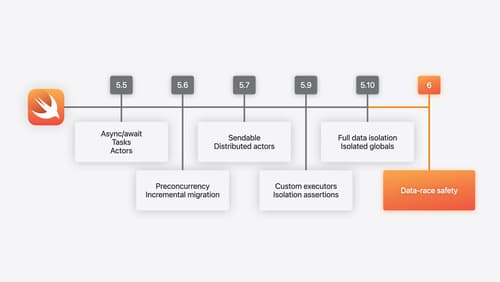How do I move my project to Swift 6?
Asked on 2024-08-03
1 search
To move your project to Swift 6, you can follow a structured process as outlined in the WWDC sessions. Here are the key steps:
-
Enable Complete Concurrency Checking:
- This is a per-module setting that leaves your project in Swift 5 mode but enables warnings for all the code that would fail with Swift 6's enforced data isolation.
- Go through and resolve all these warnings for each target in your project.
-
Enable Swift 6 Mode:
- Once you have resolved the warnings for a target, enable Swift 6 mode for that target. This locks in all your changes and prevents any future refactorings from regressing to an unsafe state.
- Repeat this process for each target in your project.
-
Incremental Migration:
- You can migrate to Swift 6 incrementally, one module at a time. This means you don't need to wait for all your dependencies to migrate before you start.
- When your dependencies do migrate, you don't need to make any changes to your code until you decide to use the new language mode.
-
Compiler Diagnostics:
- The new Swift 6 compiler diagnostics will guide you towards the places in your code that need fixing, acting like a pair programmer pointing out potential bugs.
-
Adopt Concurrency Features:
- Swift 6 introduces full data isolation enforcement, which helps catch mistakes in concurrent code at compile time. This is especially useful for eliminating hard-to-reproduce crashes and ensuring that new concurrency changes don't introduce data races.
-
Follow the Migration Guide:
- Swift.org provides a migration guide with insights and patterns on how best to modify your code to eliminate data races.
For a detailed walkthrough, you can refer to the session Migrate your app to Swift 6 (06:20).
Relevant Sessions
These sessions provide comprehensive guidance on the new features in Swift 6 and the migration process.

What’s new in Swift
Join us for an update on Swift. We’ll briefly go through a history of Swift over the past decade, and show you how the community has grown through workgroups, expanded the package ecosystem, and increased platform support. We’ll introduce you to a new language mode that achieves data-race safety by default, and a language subset that lets you run Swift on highly constrained systems. We’ll also explore some language updates including noncopyable types, typed throws, and improved C++ interoperability.

Platforms State of the Union
Discover the newest advancements on Apple platforms.

Migrate your app to Swift 6
Experience Swift 6 migration in action as we update an existing sample app. Learn how to migrate incrementally, module by module, and how the compiler helps you identify code that’s at risk of data races. Discover different techniques for ensuring clear isolation boundaries and eliminating concurrent access to shared mutable state.
